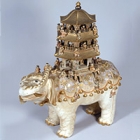Japanese Gallery (Honkan) Room T2
April 7, 2015 (Tue) - May 17, 2015 (Sun)
Elephants are the largest animals on land. With long trunks and big ears, they saunter, eat tree branches, and bathe skillfully using their trunks. Children as well as adults seem to find such behavior charming. Perhaps, we humans admire elephants' long trunks, which we do not have.
Elephants are also strong, intelligent animals. Asian elephants, which are known for their intelligence, live in southern countries such as India and Thailand. In these countries, people have used elephants for farming and carrying goods. Elephants also appear in Indian myths and Buddhist stories. In these stories, elephants are depicted as messengers of gods, or gods themselves. People who used elephants in their daily lives became attached to them and created daily utensils and artworks with elephant designs.
In Japan, where no wild elephants live, people had not seen them in person. They created their own images of elephants based on the stories and paintings brought from overseas. It was during the Muromachi period (1392–1573) when an elephant was brought into Japan for the first time. Before that, elephants seemed like imaginary animals to the people of Japan.
Elephant-themed artworks created in Asian countries including Japan have been brought together for this exhibition. The unique elephants on display all look cheerful in their own ways, as if they were about to start sauntering rhythmically. We hope that visitors will enjoy this parade of elephants.
This exhibition is held as part of this year's annual commemorative event for International Museum Day, "In Search of Elephants," which is scheduled for May 17 (advance booking required). This event is organized jointly by three institutions in Ueno Park: Ueno Zoological Gardens, the National Museum of Nature and Science, and the Tokyo National Museum. Objects on exhibit include those lent by the Ueno Zoological Gardens :an elephant tooth and tusk ,as well as a horn of a Bovidae animal, a material for making whistles used to lead elephants.

